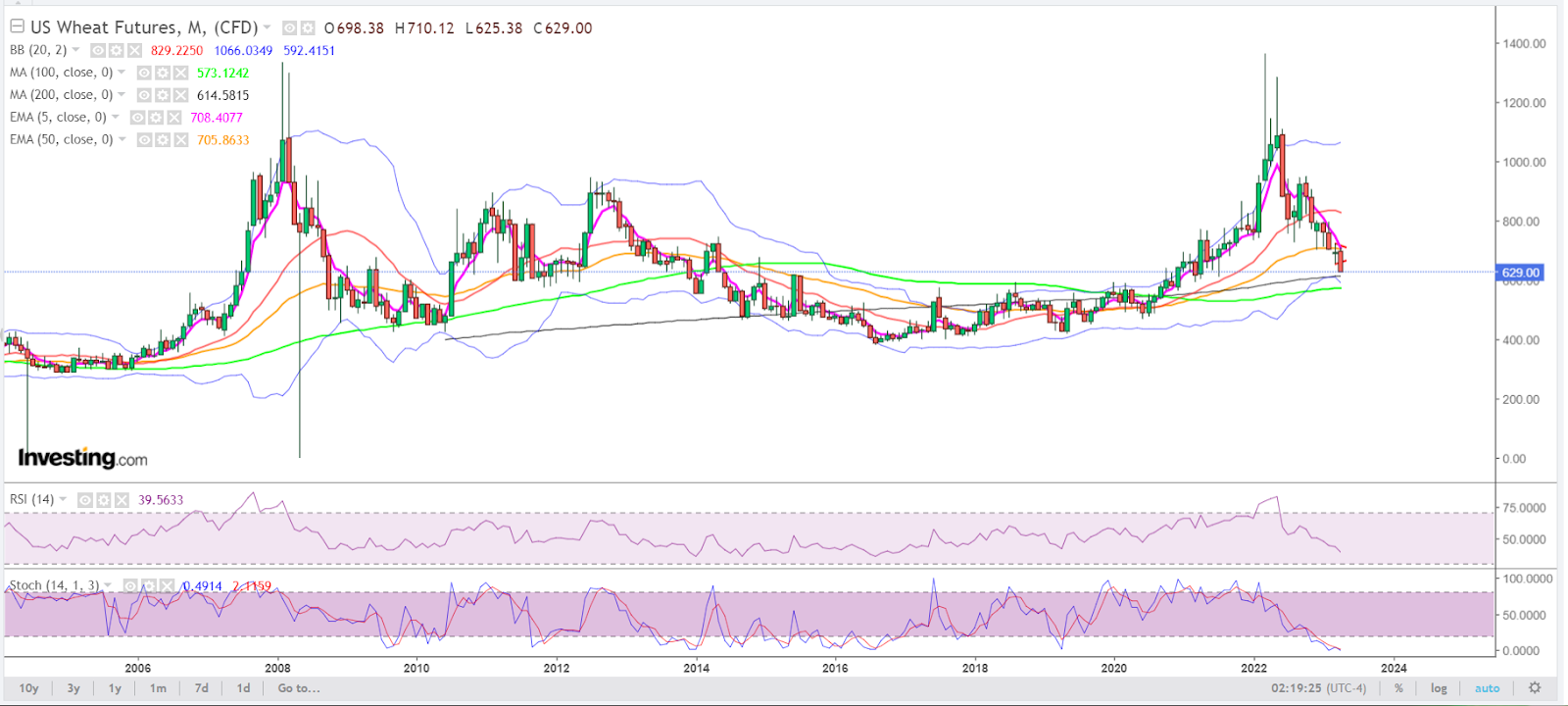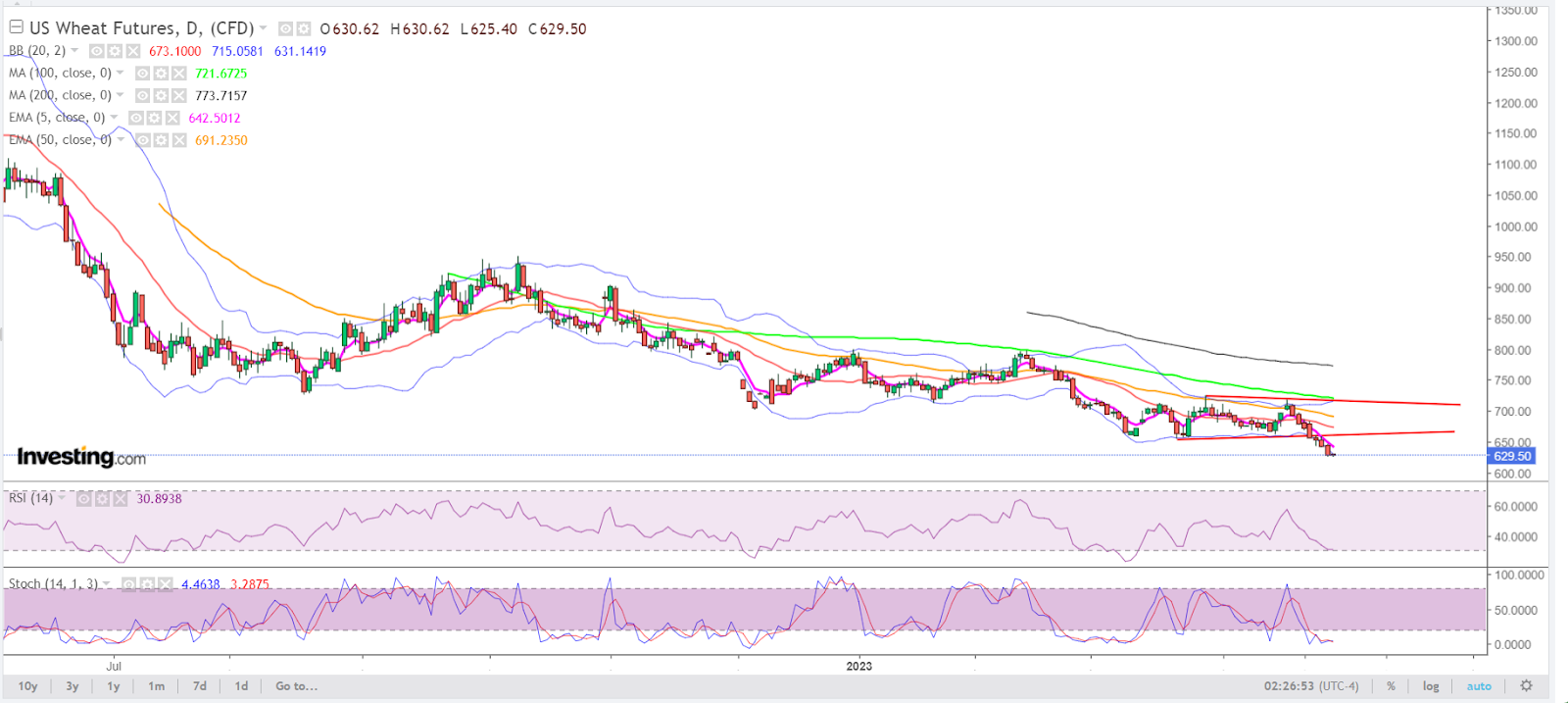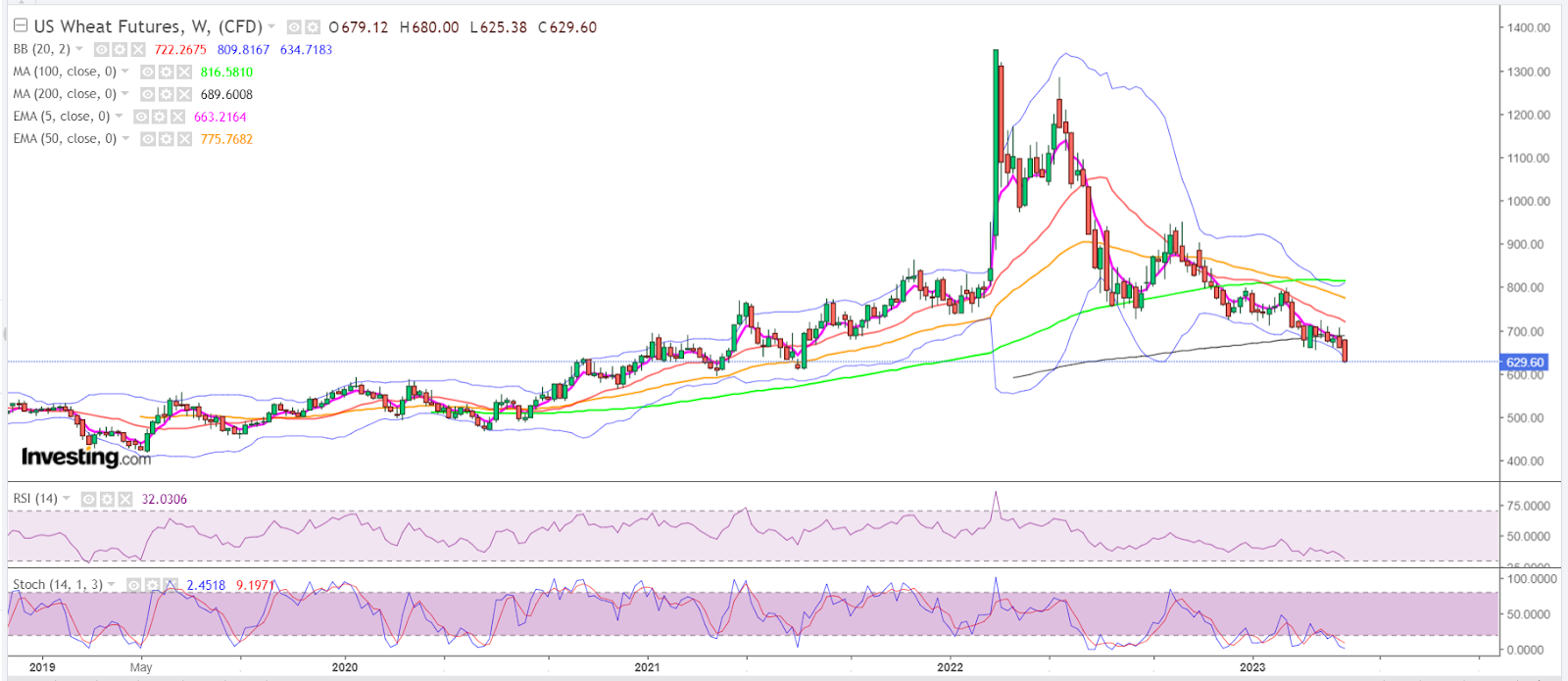- Wheat down 7th straight month in April, losing more than 30% since Sept
- Front-month on CBOT eyes close below $6.30/bushel vs Sept close above $9.20
- Wheat weakened by massive oncoming Russian, Australian harvests
- Moscow’s holdout on Black Sea grain deal limits downside after 21-month lows
A year ago, wheat couldn’t stop rallying, hitting record highs as Russia’s invasion of Ukraine created fears of a massive shortage in the grain. Now, wheat prices can’t stop falling — thanks again to Russia, helped by Australia.
As Jack Scoville, chief crop analyst at Chicago commodities broker Price Futures Group, put it in a note on wheat issued on Thursday:
“Ideas that big Russian offers and cheaper Russian prices would be a feature for a while in the world market is the driving force for the weaker prices. Ideas are that both Australia and Russia are harvesting record [or] near record wheat crops this year. Both countries will have a lot of wheat to export.”
With markets entering their final session for April on Friday, wheat is down more than 9% for this month. It’s a freefall that’s been in force since October, with seven straight months of losses that have cumulatively wiped out 32%, or nearly $3, off a bushel of wheat. Charts by SKCharting.com, with data powered by Investing.com
Charts by SKCharting.com, with data powered by Investing.com
From a settlement above $9.20 a bushel at end-September, the front-month contract in wheat on the Chicago Board of Trade is now staring at a potential close of below $6.30. At this time last year, wheat was trading at well above $10 a bushel after hitting record highs above $13.62 a bushel in March, shortly after the invasion of Ukraine.
The question for investors, of course, is whether the red streak of the past seven months will continue or whether wheat is poised to enter positive territory.
Aside from technicals, supply fundamentals and the political story in wheat will also likely yield answers to that.
Fundamental & Political Context
The broader story in wheat is the future of the Black Sea grain deal, which is to expire soon, without a clear outcome as Russia holds out on its commitment to the arrangement despite Ukraine’s demand that world powers pressure Moscow for an amicable solution.
The Black Sea grain deal, brokered between Russia and Ukraine by the United Nations and Turkey in July, aims to prevent a global food crisis by allowing Ukrainian grain trapped by Russia's invasion to be safely exported from three ports.
UN chief Antonio Guterres, in a letter to Russian President Vladimir Putin, has proposed a “way forward aimed at the improvement, extension and expansion” of the deal, which will expire on May 18. Guterres had asked Russian Foreign Minister Sergey Lavrov to deliver the letter to Putin, after meeting at the UN headquarters on Monday. Lavrov said Moscow would study the letter.
Ukrainian presidential adviser Mikhail Podolyak supported Guterres’ letter, saying Guterres’s initiative can succeed only “if the international community collectively pressures Russia”.
“Ukraine, on the other hand, will continue to follow the agreements with Turkey and the UN and will continue to deliver grain cargoes to their destination, solving the problem of global food supply,” he added.
On Tuesday, the Kremlin said that a global shortfall in food supplies could not be wholly attributed to Russia and Ukraine, and reiterated that the deal was not working for Moscow.
Russia’s defense ministry has accused Ukraine of using the grain corridor to attack Russian vessels in the Black Sea, while former Russian President Dmitry Medvedev threatened Moscow’s withdrawal should G7 countries ban exports to Russia.
Kremlin spokesman Dmitry Peskov told reporters, “Despite the fact that so much time has passed, [the deal] has not yet been implemented, it has not come together as a package, the conditions that concerned us have still not been realized. Therefore, while the circumstances don’t add up in favour of this deal, we continue to observe.”
The potential breakdown in the Black Sea grain deal has been somewhat supportive to wheat prices, limiting their downside even as the front-month on the Chicago Board of Trade hovers at 21-month lows of just above $6.25 a bushel.

Wheat Daily
On the flip side, pressuring wheat were runaway Russian and Australian harvests.
The U.S. Department of Agriculture estimates that Russia’s wheat production for 2022/23 will be a record 92.0 million metric tons, up 22 percent from last year and 18 percent above the 5-year average. The estimate includes 68 million metric tonnes of winter wheat and 24 million of spring wheat.
In Australia, the harvest is also expected to be the largest for a season in Western Australia, followed by New South Wales. In Western Australia, estimates for full-year wheat production are at 13.8 million metric tonnes, up from December's forecast of 13 million metric tonnes.
Technical Outlook
 Following a seven-month streak in the red, wheat looks poised for a return to the black, provided the $6-per-bushel support doesn’t give way, SKCharting.com chief technical strategist Sunil Kumar Dixit said. He adds:
Following a seven-month streak in the red, wheat looks poised for a return to the black, provided the $6-per-bushel support doesn’t give way, SKCharting.com chief technical strategist Sunil Kumar Dixit said. He adds:
“Wheat Futures have approached the 200-month Simple Moving Average, or SMA, of $6.14, which is very likely to stop the fall. However, if the selloff extends below this zone, expect a further drop to the 100-month SMA of $5.73.”
Dixit said the aforementioned zones were significant levels on both the broader and “noise-free” time frames.
“An upward rebound may begin from these support areas, initially targeting the 200-week SMA of $6.90.”
***
Disclaimer: The content of this article is purely to educate and inform and does not in any way represent an inducement or recommendation to buy or sell any commodity or its related securities. The author Barani Krishnan does not hold a position in the commodities and securities he writes about. He typically uses a range of views outside his own to bring diversity to his analysis of any market. For neutrality, he sometimes presents contrarian views and market variables.

